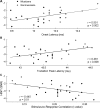Musical experience limits the degradative effects of background noise on the neural processing of sound
- PMID: 19906958
- PMCID: PMC6665054
- DOI: 10.1523/JNEUROSCI.3256-09.2009
Musical experience limits the degradative effects of background noise on the neural processing of sound
Abstract
Musicians have lifelong experience parsing melodies from background harmonies, which can be considered a process analogous to speech perception in noise. To investigate the effect of musical experience on the neural representation of speech-in-noise, we compared subcortical neurophysiological responses to speech in quiet and noise in a group of highly trained musicians and nonmusician controls. Musicians were found to have a more robust subcortical representation of the acoustic stimulus in the presence of noise. Specifically, musicians demonstrated faster neural timing, enhanced representation of speech harmonics, and less degraded response morphology in noise. Neural measures were associated with better behavioral performance on the Hearing in Noise Test (HINT) for which musicians outperformed the nonmusician controls. These findings suggest that musical experience limits the negative effects of competing background noise, thereby providing the first biological evidence for musicians' perceptual advantage for speech-in-noise.
Figures




Similar articles
-
Musical training enhances neural processing of binaural sounds.J Neurosci. 2013 Oct 16;33(42):16741-7. doi: 10.1523/JNEUROSCI.5700-12.2013. J Neurosci. 2013. PMID: 24133275 Free PMC article.
-
Context-dependent encoding in the auditory brainstem subserves enhanced speech-in-noise perception in musicians.Neuropsychologia. 2011 Oct;49(12):3338-45. doi: 10.1016/j.neuropsychologia.2011.08.007. Epub 2011 Aug 16. Neuropsychologia. 2011. PMID: 21864552 Free PMC article.
-
Musician enhancement for speech-in-noise.Ear Hear. 2009 Dec;30(6):653-61. doi: 10.1097/AUD.0b013e3181b412e9. Ear Hear. 2009. PMID: 19734788
-
Emergence of biological markers of musicianship with school-based music instruction.Ann N Y Acad Sci. 2015 Mar;1337:163-9. doi: 10.1111/nyas.12631. Ann N Y Acad Sci. 2015. PMID: 25773631 Review.
-
Turning down the noise: the benefit of musical training on the aging auditory brain.Hear Res. 2014 Feb;308:162-73. doi: 10.1016/j.heares.2013.06.008. Epub 2013 Jul 2. Hear Res. 2014. PMID: 23831039 Review.
Cited by
-
Perceptual and neuronal boundary learned from higher-order stimulus probabilities.J Neurosci. 2013 Feb 20;33(8):3699-705. doi: 10.1523/JNEUROSCI.3166-12.2013. J Neurosci. 2013. PMID: 23426696 Free PMC article.
-
Long-term music instruction is partially associated with the development of socioemotional skills.PLoS One. 2024 Jul 18;19(7):e0307373. doi: 10.1371/journal.pone.0307373. eCollection 2024. PLoS One. 2024. PMID: 39024268 Free PMC article.
-
Subcortical encoding of sound is enhanced in bilinguals and relates to executive function advantages.Proc Natl Acad Sci U S A. 2012 May 15;109(20):7877-81. doi: 10.1073/pnas.1201575109. Epub 2012 Apr 30. Proc Natl Acad Sci U S A. 2012. PMID: 22547804 Free PMC article.
-
Brain responses to musical feature changes in adolescent cochlear implant users.Front Hum Neurosci. 2015 Feb 6;9:7. doi: 10.3389/fnhum.2015.00007. eCollection 2015. Front Hum Neurosci. 2015. PMID: 25705185 Free PMC article.
-
Musical experience partially counteracts temporal speech processing deficits in putative mild cognitive impairment.Ann N Y Acad Sci. 2022 Oct;1516(1):114-122. doi: 10.1111/nyas.14853. Epub 2022 Jun 28. Ann N Y Acad Sci. 2022. PMID: 35762658 Free PMC article.
References
-
- Ahissar M. Dyslexia and the anchoring-deficit hypothesis. Trends Cogn Sci. 2007;11:458–465. - PubMed
-
- Aiken SJ, Picton TW. Envelope and spectral frequency-following responses to vowel sounds. Hear Res. 2008;245:35–47. - PubMed
-
- Besson M, Schön D, Moreno S, Santos A, Magne C. Influence of musical expertise and musical training on pitch processing in music and language. Restor Neurol Neurosci. 2007;25:399–410. - PubMed
Publication types
MeSH terms
LinkOut - more resources
Full Text Sources
Medical
